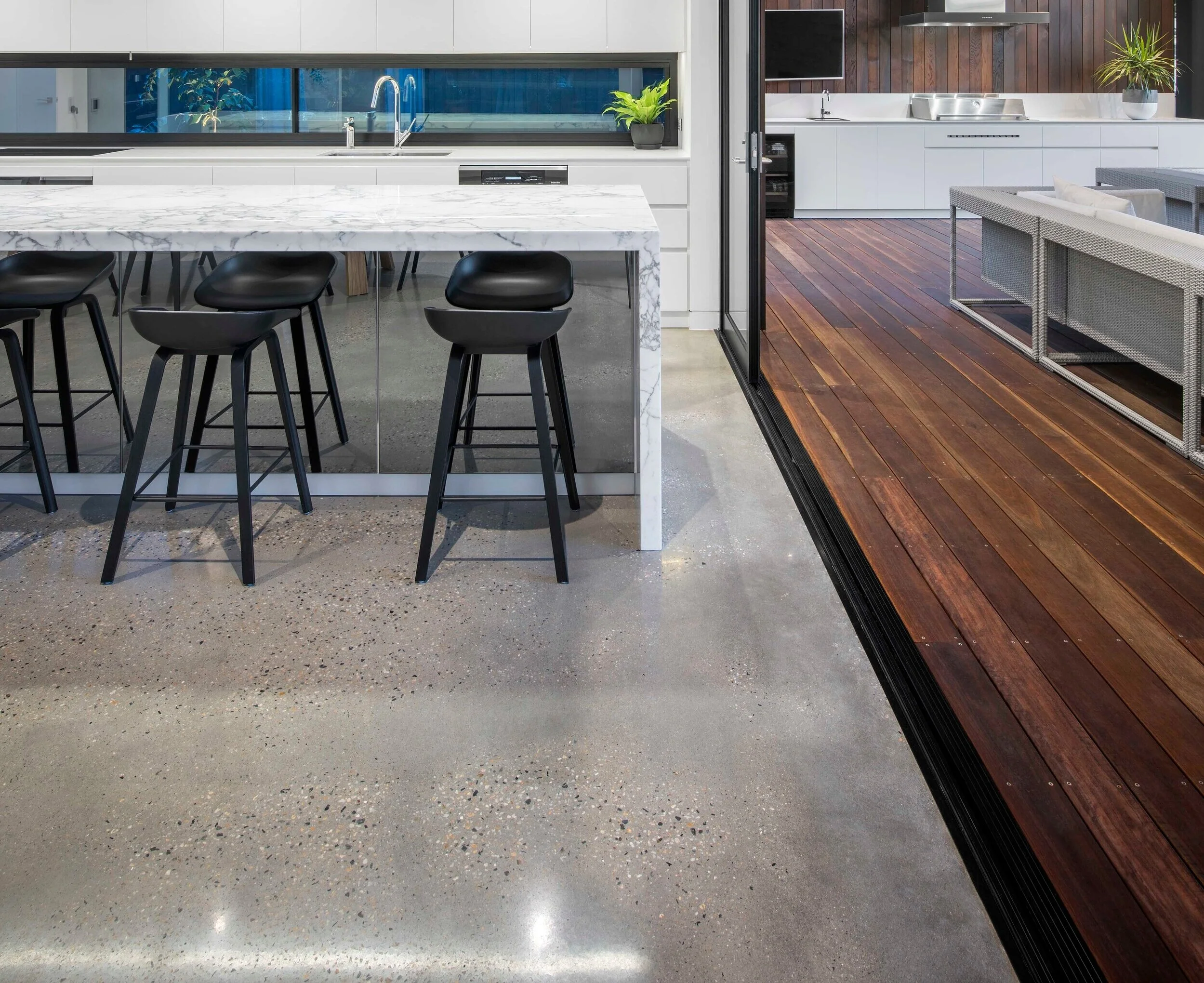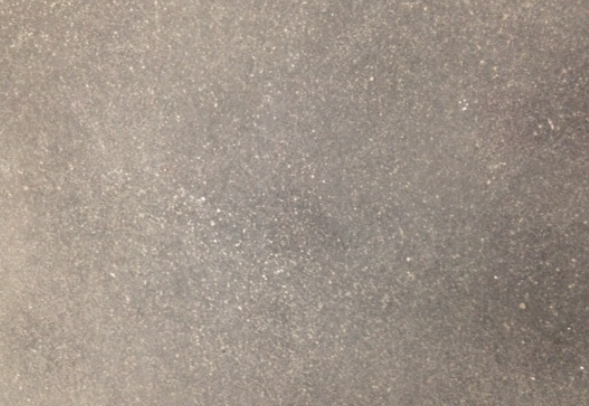1. I know you offer two different ‘polished concrete’ styles. Can you explain their differences to me?
The LC Polished Concrete system is a chemical and mechanical process which transforms the concrete surface into a super hard, smooth, attractive finish and is sealed with a penetrating sealer. The advantage of a penetrating sealer is that the concrete is sealed internally, making the surface as durable as possible. In future the floor can be easily rejuvenated by buffing using diamond impregnated pads. Concrete selection, specification and quality plays a large part in determining the final gloss level achievable and this is why some existing concrete can not be polished using this method and why some floors polish to a higher gloss level than others.
If a super gloss finish is your priority we can apply a very thin film topical sealer to increase the gloss levels. This option must be specified from the beginning and one disadvantage to this option is it is less durable and requires more regular maintenance to keep the floor looking its best.
Topically sealed floors are ground and honed to achieve a similar appearance to an LC polished concrete floor but are finished with a clear surface film. The gloss level of the clear coating can be selected in a matt, satin or gloss finish. Many existing floors respond better to this type of finish as the quality of the concrete can be variable and this process can still be successful. As this finish is a plastic film applied to the surface of the floor, it is more prone to scratching and high traffic areas can become dull over time. Resealing of this type of floor in future is labour intensive as it requires lightly sanding and reapplication of the sealer, followed by curing time.
2. Will my floor need ongoing maintenance?
Following our maintenance guide will extend the life of your floor but with average household wear, your floor should only need re-sealing no sooner than 3 to 5 years.
3. I like the terrazzo look, with stones exposed in the concrete. Do you offer this and how do I specify it?
We offer four different levels of aggregate exposure:
Penfolds Magill Estate Winery LC Burnished finish.
Sample LC Minimal Aggregate finish.
Private Residence LC Salt & Pepper finish.
Private Residence LC Full Aggregate finish.
Burnished: The surface of the concrete is polished to maintain the appearance of trowel marks and colour variation. No aggregate should be exposed with this option and there will be natural colour variation throughout the slab. The placing and finishing of the slab by your concreter will dictate the appearance of the final finished floor as we do not cut back the surface at all.
Minimal aggregate: The thin paste layer on the surface of the concrete is honedoff with a fine grit diamond pad to expose only the fine sand within the surface of the concrete. Please note that even small variances in the flatness of the concrete can cause areas of aggregate to be exposed. For this reason, correct placing and finishing of the slab is crucial to achieve a minimal aggregate finish.
Salt & Pepper: 1 to 2mm is ground from the surface of the concrete to expose patches of aggregate. The locations where aggregate exposure occurs is dictated by how the concrete was placed and finished as the aggregate is naturally moved around the floor and ends up at differing levels within the slab. Flatness of the floor is most important to the finished product so we can not grind down localised areas to try to achieve more aggregate exposure. In specifying a salt & pepper finish, you can request a lighter or heavier version but the location of the aggregate is out of our control. Straight lines or unusual shapes of aggregate exposure are caused by inconsistencies in the placement of the concrete.
Full aggregate: A full aggregate exposure finish is achieved by grinding between 2-3mm off of the surface to reveal the larger aggregates within the mix. To achieve this we require the slab to be placed as flat as possible with attention being paid to not push the aggregate down with either the screed bar or boots and to try and keep the aggregate as close to the surface as possible. As with the Salt and pepper finish we cannot grind down localised areas to try and expose more aggregate as this adversely affects the polishing process.
4. Why should I choose polished concrete rather than more traditional floor coverings?
Polished concrete is a great option from a design perspective as it is customisable in colour and texture, seamless, suits many styles, can be used both internally and externally and can be incorporated into many areas of a project including furniture and fixtures. Polished concrete is very durable and can also be refurbished many times over making it a great choice environmentally.
5. Can I achieve a smooth transition from my polished concrete inside to our outdoor entertaining area?
Polished concrete is suitable for both internal and external use however, in external areas we do not polish up to as high a gloss level as internal areas for slip resistance reasons. Different sealers are used for internal and external areas and although they look similar they are not identical in colour and texture.
Osteria Oggi LC bench (21 metres long!) with matching LC burnished floor.
6. Can I match our concrete floor to our LC concrete benchtop, hearth or other LC made pieces?
We can match floors when constructing our benchtops and furniture using our wet cast concrete method (In-situ). For more detailed information on how our benchtops and concrete objects are made please see our Benchtop FAQ.
7. Do you pour concrete floors?
We choose to focus on the finishing of concrete floors and custom concrete objects but may be able to assist with smaller more complex concreting projects.
8. How long until I can walk on the floor after it has been coated or sealed?
Penetrating sealers: we recommend leaving the floor for 24 hours after it has been sealed before walking on it. (light foot traffic only). The sealer is fully cured within 7 days.
Topical sealers: we recommend leaving the floor for 24 - 48 hours after it has been fully coated before walking on it (light foot traffic only). The sealer is fully cured within 7 days.
9. Will there be dust from the concrete floor grinding?
Yes. Grinding concrete creates dust, and although our vacs pick up the majority of it, the dust may still be airborne and may be found in other parts of the house. This is unavoidable but we do our best to keep the dust to a minimum by using dust extraction units. We recommend removing or protecting any items which may be sensitive to dust or are easily damaged.
10. What other products and services do you offer?
Apart from all of your concrete polishing needs we also do industrial and epoxy floor coatings, concrete grinding, glue removal, timber and parquetry floor sanding and polishing, concrete benchtops and furniture.
11. How can I get more information?
If you have further questions please don’t hesitate to Contact Us.
Please browse our site, Instagram and Facebook pages for more information and inspiration.
Alternately, you can view examples at our showroom at 274 Pulteney St, Adelaide.



